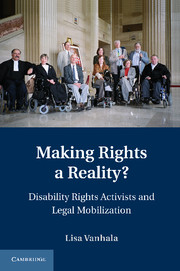Book contents
- Frontmatter
- Contents
- List of Figure and Tables
- Acknowledgments
- Abbreviations
- 1 Introduction: Legal Mobilization and Accommodating Social Movements
- 2 Rights and Political Identity in the Canadian Disability Movement
- 3 Disability Equality and Opportunity in the Supreme Court of Canada
- 4 Disability Organizations and the Diffusion of Rights in the United Kingdom
- 5 Framing Disability Equality in the UK Courts
- 6 Conclusions: Litigation, Mobilization, and Social Movements
- Bibliography
- Index
6 - Conclusions: Litigation, Mobilization, and Social Movements
Published online by Cambridge University Press: 03 May 2011
- Frontmatter
- Contents
- List of Figure and Tables
- Acknowledgments
- Abbreviations
- 1 Introduction: Legal Mobilization and Accommodating Social Movements
- 2 Rights and Political Identity in the Canadian Disability Movement
- 3 Disability Equality and Opportunity in the Supreme Court of Canada
- 4 Disability Organizations and the Diffusion of Rights in the United Kingdom
- 5 Framing Disability Equality in the UK Courts
- 6 Conclusions: Litigation, Mobilization, and Social Movements
- Bibliography
- Index
Summary
INTRODUCTION
The sociolegal implications of disability have changed enormously. In the late 1970s, disability rights were not only nonexistent, they were largely inconceivable. Policy makers and even the majority of people with disabilities themselves unquestioningly accepted that pity, charity, and paternalism, rather than rights provisions, were the most appropriate responses to the problems of poverty and social exclusion associated with disability. Thirty years later, the legal status of people with disabilities in Canada and the United Kingdom has been radically altered: the concept of disability is now considered as much the domain of citizenship and inclusion policy as welfare policy, and equality provisions are now constitutionally and statutorily entrenched.
The “rights revolution” in the realm of disability has been influenced by, and in turn has influenced, a significant change in the social construction of disability among crucial constituencies: specifically, a change from a medicalized, individual model of disability to a sociocontextual model. At the crux of the social model is the notion that “a disability is then not something that is just wrong with a person, but rather it is a site of difference that exposes hegemony and injustice in the normal workings of the world. The problem is the stairs, not the legs of the person who uses a wheelchair to get around.” This new understanding was developed and diffused by activists and disability studies academics to challenge the underpinnings of existing disability paradigms focused on rehabilitation and medicalized notions of the individual.
- Type
- Chapter
- Information
- Making Rights a Reality?Disability Rights Activists and Legal Mobilization, pp. 247 - 272Publisher: Cambridge University PressPrint publication year: 2010



